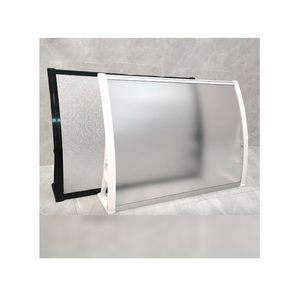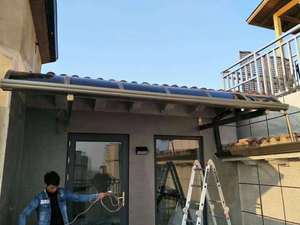(369 products available)





























































































































































































































A DIY sun rain cover is a custom-made solution designed to protect against sun and rain. These covers can be made at home using various materials and designs to fit different needs and preferences.
Fabric covers
Fabric covers are one of the most common DIY sun and rain cover solutions. They are usually made from waterproof or water-resistant fabrics such as nylon, polyester, or acrylic. These fabrics are lightweight and easy to work with, making them suitable for creating custom covers for patios, outdoor furniture, or even boats. Fabric covers can be designed in various ways, from simple drapes that hang over an object to more complex structures with frames. They offer flexibility regarding size and shape since the fabric can be cut and sewn to fit nearly anything. Additionally, fabric covers can be made transparent, allowing for visibility and natural light while still providing protection from the elements.
Wooden structures
Wooden structures make a great cover for areas that need to be protected from sun and rain. Wood is a popular material for DIY sun and rain covers, along with other materials like metal, plastic, and fabric. Wood is strong and can be shaped into different forms, such as awnings, pergolas, and shade sails. It can be treated or painted to protect it from the sun and rain. This makes wooden structures last longer, especially outside where they are exposed to the weather.
Plastic/metal awnings
Plastic and metal awnings are ready-made products that can be easily installed over doors, windows, or patios. They provide excellent protection from rain and shade from the sun. DIY covers can also be made using polycarbonate sheets, which are durable and offer UV protection. These sheets can create covers for outdoor seating areas, grills, or equipment.
PVC pipe frames
PVC pipes are a popular choice for creating frames for fabric or plastic covers. They are lightweight, affordable, and easy to assemble. Another option is to use metal pipes or wood to make frames. These materials are sturdier and can support heavier covers.
Tarpaulins
Tarpaulins, or tarps, are heavy-duty, waterproof fabric sheets often used for covering and protecting things. They are made from materials like canvas, polyester, or polyethylene. Tarpaulins are strong, durable, and can handle being outside in different weather conditions. They can be used in many ways, such as making DIY sun and rain covers for patios, outdoor furniture, and boats.
Some design aspects of the sun rain cover are listed below.
Size and Shape:
The size and shape of the sun and rain cover usually depend on the item for which it is made. For example, when making covers for outdoor furniture, the size and shape of each piece are taken into account. On the other hand, when making car covers, the size and shape of the car are considered. Similarly, when making patio umbrella rain covers, the shape of the umbrella is considered. In all cases, the size and shape of the item are measured to ensure that the cover fits well and works properly.
Materials:
DIY sun and rain covers are made from materials that are suitable for both sun and rain. Outdoor furniture covers are usually made from strong materials like polyester or vinyl that can withstand being outside and are resistant to sunlight and rainfall. Car covers are made from breathable materials that keep the car dry and protect it from the sun. Patio umbrella covers are made from water-resistant materials that keep the umbrella dry and protect it from sunlight.
Color Options:
DIY sun and rain covers can be obtained in different color options. Covers for outdoor furniture and cars are usually made in colors that match well with anything. But when it comes to umbrella covers, they are usually made in brighter colors that reflect the sun's rays and keep the umbrella and those using it cool.
Closure Systems:
Each cover has its own closure system, which makes it easy to use. Covers for outdoor furniture and cars use straps, buckles, or drawstrings to hold the cover in place. Umbrella covers use Velcro straps or ties to secure the cover around the base of the umbrella. These closure systems are designed to be simple and easy to use, so anyone can put the cover on or take it off quickly.
Waterproof Layer:
Rain covers are made with a waterproof layer that keeps the item dry even in wet weather. This waterproof layer is usually laminated onto the outside of the cover material. This means that no water can get inside the cover to wet the item.
DIY sun and rain covers are versatile and can be used in various situations to provide protection from adverse weather conditions. Some common usage scenarios include:
Outdoor furniture:
DIY sun and rain covers can protect outdoor furniture such as patio chairs, tables, and loungers. Whether it is a set of cushions or a full patio dining set, a DIY cover made of durable materials like vinyl or canvas can keep the furniture dry and free from rust or mildew. It can also prevent the furniture from fading or cracking due to prolonged sun exposure.
Kids' play area:
A DIY sun and rain cover over a kid's outdoor play area or sandbox can provide a sheltered space for kids to play regardless of the weather. It can protect the play equipment and toys from getting wet due to rain and the kid's body from harmful UV rays. It also helps maintain the sand's consistency by preventing rain from wetting it and keeping animals away from it.
Garden area:
A sun and rain cover can provide protection for delicate plants and flowers in a garden area. It can be placed over a specific section of the garden or a greenhouse. The cover can shield the plants from heavy rain that can damage them or wash away fertilizers and soil. It can also protect the plants from harsh sun heat and harmful UV rays, especially during dry seasons or in areas with intense sunlight.
Vehicles:
DIY covers are also used to protect bicycles, motorcycles, and other outdoor equipment and vehicles from sun and rain. It can prevent the tires and seats from cracking or getting water-damaged and reduce the frequency of cleaning the vehicles.
Determine the purpose and requirements:
When selecting a DIY sun rain cover, users must consider the needs and intended usage. Users should ask themselves some questions. Do they want to block harsh sunlight or harmful UV rays? Or do they want to provide protection against rain and light showers? Do they need it for outdoor furniture, vehicles, or patios? Covering furniture requires a more extensive design, while vehicle covers need to fit specific shapes. The intended use will determine the materials, size, and design of the cover.
Consider the weather conditions:
Next, users should evaluate the local weather conditions. If users experience heavy rainfall, consider a cover with waterproof materials or coatings. If users experience high temperatures, look for features like UV protection or reflective coatings. Covers with these features can prevent users' belongings from fading and overheating.
Select appropriate materials:
Some materials are suitable for sun rain covers. Polyester with PU coating is waterproof and durable. PVC is also a popular material for covers as it is water-resistant and easy to clean. Canvas with treatments is a strong and long-lasting option. It can resist both sun and rain. Users should choose a material based on their needs and weather conditions.
Customization and measurements:
If users want to make a cover, they should measure the area it needs to cover accurately. Then, they should gather the necessary materials based on the preferred design. Some common DIY cover designs include fitted wraps, tarp-style covers, and pop-up canopies. Fitted wraps are great for items with specific shapes. Tarp-style covers use bungee cords or clips for adjustable coverage. A canopy provides shaded space while protecting from rain.
Easiness to use:
Ease of use is another factor to consider. How easy is it to put on or remove? How simple is it to store when not in use? A user-friendly cover saves time and effort, making it more convenient.
Durability and material quality:
Opt for a cover with good-quality materials. These covers will last longer and do their job well. They won't tear easily and will keep their waterproof and UV-protective qualities over time.
Ventilation:
A good ventilation feature prevents moisture buildup. It stops mold and mildew growth. Some covers have mesh panels or vents. They allow air to circulate even when the cover is in place.
Storage and portability:
Lastly, consider the cover's portability and storage. Some covers are light and foldable. They are easy to store when not in use. Others may be bulkier but offer better protection. Find a balance between portability and practicality based on users' needs.
Q1: Why is a DIY sun rain cover important?
A1: It protects against bad weather and intense sunlight. It also keeps things like cars and furniture from getting ruined.
Q2: What materials can be used for a DIY sun rain cover?
A2: Covers can be made from strong tarps, waterproof cloths, or even old umbrellas and wood.
Q3: How do users make a simple tarp cover?
A3: They can find instructions online, but basically, it's about choosing the right size tarp and securing it properly.
Q4: What are the benefits of using a DIY sun rain cover?
A4: They can customize it to fit their needs, save money, and often make it using readily available materials.
Q5: How can one ensure their DIY cover is secure during storms?
A5: Use strong ties and weights to keep it in place.